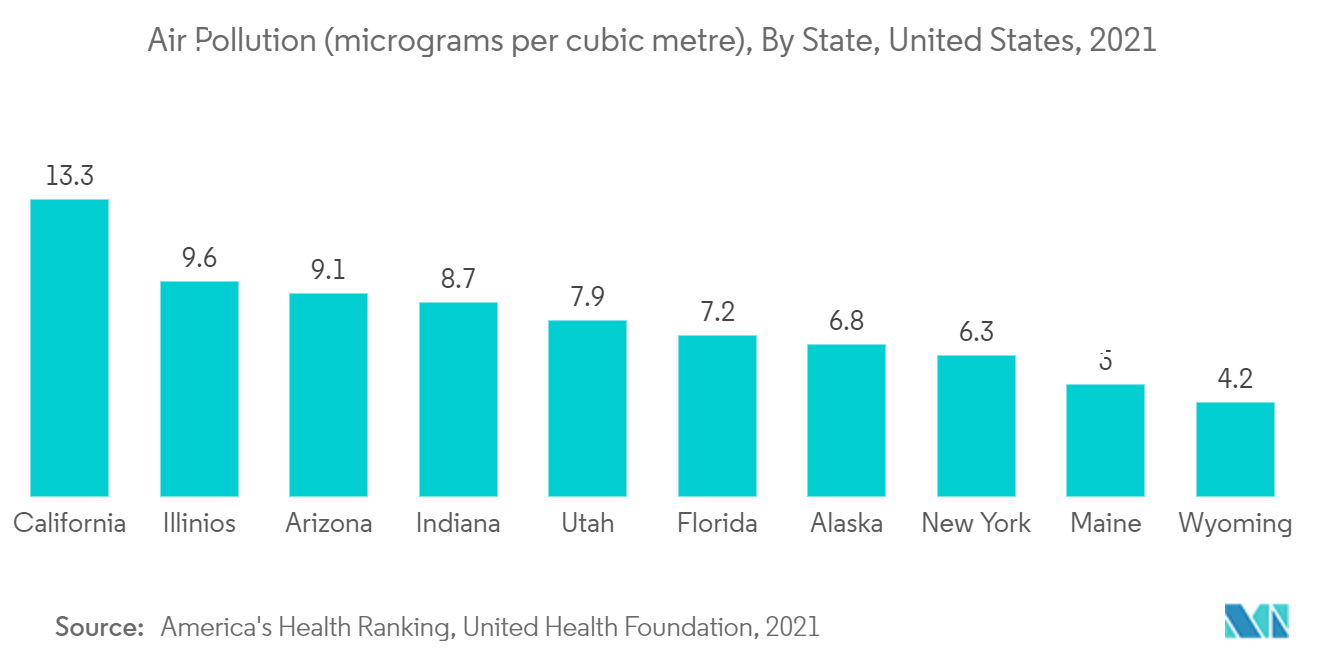Market Trends of Allergy Diagnostics Industry
Inhaled Allergens Segment Expects to Register a High CAGR in the Allergy Diagnostics Market Over the Forecast Period
- Inhaled allergies are the most common type of allergy. They can be triggered by several airborne pollutants, both indoors and outdoors. Seasonal inhalant allergies, often known as hay fever, are particularly prevalent. Common outdoor allergens include pollen, mold spores, fungi, dust, and other irritants, while indoor allergens encompass animal dander, dust mites, fragrances, and more.
- The inhaled allergens segment is anticipated to experience substantial growth in the allergy diagnostics market over the forecast period. This surge is attributed to factors such as increasing environmental pollution, a rise in respiratory allergies and asthma cases globally, and the heightened demand for allergy testing. For example, according to 2022 statistics from the National Health Service, approximately 1.17 million people in England were diagnosed with chronic obstructive pulmonary disorder (COPD) in 2020-2021, accounting for 1.9% of the total population.
- Additionally, the Occupational Lung Disease statistics in Great Britain for 2021 recorded an estimated 17,000 new cases of breathing and lung problems each year, many of which were either caused or exacerbated by workplace conditions. These alarming rates of respiratory issues are projected to drive the demand for allergy diagnostic devices during the forecast period.
- Moreover, due to rapid urbanization, industrialization, and resulting lifestyle changes, many countries have experienced a sharp increase in air pollutants, leading to a rise in allergies like asthma and allergic rhinitis. For example, according to the World Air Quality Report by IQAir in March 2022, India ranked as the fifth most polluted country among 117 countries, regions, and territories worldwide. The annual average PM2.5 levels reached 58.1 micrograms per cubic meter (µg/m3) in India in 2021. Consequently, with the escalation of airborne allergens, the necessity for early diagnosis and treatment is expected to grow, thus fueling the demand for diagnostic tests and systems that identify the pollutants causing allergies, ultimately boosting market growth.
- Additionally, the presence of key market players and their strategic initiatives is projected to reinforce the demand for allergy diagnostic devices. For instance, in June 2022, Oncologica launched Allergyfocus, a new antibody allergy test that swiftly and accurately detects 99% of common global allergies. This test provides a comprehensive, personalized antibody profile of a patient’s allergy triggers for precise diagnosis.
- Therefore, owing to the rise in respiratory diseases and the strategic efforts of major industry players, this segment is expected to witness significant growth throughout the forecast period.

North America is Anticipated to Hold a Significant Market Share Over the Forecast Period
- North America is poised to experience substantial market growth in the field of allergy diagnostics. This growth can be attributed to various factors, including the rising incidence and prevalence of allergic diseases and related conditions, environmental pollution, increased healthcare spending, and heightened company activities.
- For instance, according to the December 2022 update from the CDC, in 2021, 4.6% of adults had been diagnosed with chronic obstructive pulmonary disease (COPD), emphysema, or chronic bronchitis, with 781,000 emergency department visits primarily due to COPD.
- The surge in COPD cases directly correlates with an increased demand for allergy diagnostic devices, thereby stimulating market growth. Additionally, the region's escalating company activities and the surge in product approvals are projected to further fuel market expansion during the forecast period.
- For example, in August 2022, the FDA approved Thermo Fisher’s ImmunoCAP Specific IgE (sIgE) Allergen Components for wheat and sesame allergies for in vitro diagnostic use, aiding healthcare providers in identifying these allergies in at-risk patients. Similarly, the FDA's approval of the ImmunoCAP Specific IgE alpha-Gal Allergen Component test in September 2021 assists in diagnosing sensitization to the alpha-Gal carbohydrate found in mammalian (red) meat, assessing the risk of anaphylactic reactions.
- Moreover, the September 2022 collaboration between RxCap, Inc. and ZEPHYRx LLC to integrate their respective remote monitoring platforms enables the monitoring of lung function in patients with serious pulmonary conditions by RxCap's enterprise customers, such as providers and payers.
- Therefore, the confluence of factors, including the rise in allergy-causing diseases and strategic initiatives by key industry players, is expected to propel significant market growth in the North American region throughout the forecast period.


